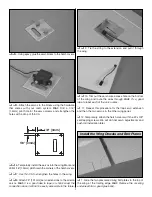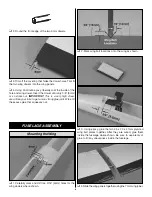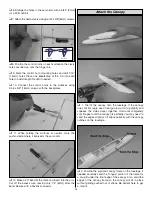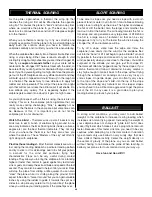
Ground check the operational range of your radio before the
first flight of the day. With the transmitter antenna collapsed and
the receiver and transmitter on, you should be able to walk at
least 100 feet away (consult your radio's instructions for the
exact distance required) from the model and still have control.
If the control surfaces do not respond correctly,
do not fly!
Find
and correct the problem first. Look for loose servo connections
or broken wires, corroded wires on servo connectors, poor
solder joints in your battery pack or a defective cell, or a
damaged receiver crystal from a previous crash.
Read and abide by the following Academy of Model
Aeronautics Official Safety Code:
1. I will not fly my model aircraft in sanctioned events, air
shows, or model flying demonstrations until it has been
proven to be airworthy by having been previously
successfully flight tested.
2. I will not fly my model aircraft higher than approximately
400 feet within 3 miles of an airport without notifying the
airport operator. I will give right of way to and avoid flying in
the proximity of full scale aircraft. Where necessary an
observer shall be used to supervise flying to avoid having
models fly in the proximity of full scale aircraft.
3. Where established, I will abide by the safety rules for the
flying site I use and I will not willfully and deliberately fly my
models in a careless, reckless and/or dangerous manner.
7. I will not fly my model unless it is identified with my name
and address or AMA number, on or in the model.
9. I will not operate models with pyrotechnics (any device
that explodes, burns, or propels a projectile of any kind).
1. I will have completed a successful radio equipment ground
check before the first flight of a new or repaired model.
2. I will not fly my model aircraft in the presence of
spectators until I become a qualified flier, unless assisted by
an experienced helper.
4. I will operate my model using only radio control frequencies
currently allowed by the Federal Communications Commission.
❏
1. Check the C.G. according to the measurements
provided in this manual.
❏
2. Be certain the battery and receiver are securely
mounted in the fuse.
❏
3. Extend your receiver antenna inside the fuselage.
❏
4. Balance your model
laterally as explained in
the instructions.
❏
5. Make sure all hinges are
securely
glued in place.
❏
6. Reinforce holes for wood screws with thin CA where
appropriate (servo mounting screws, control horns, etc.).
❏
7. Confirm that all controls operate in the correct direction
and the throws are set up according to the manual.
❏
8. Make sure there are silicone retainers on all the
clevises and that all servo arms are secured to the servos
with the screws included with your radio.
❏
9. Secure connections between servo wires and
Y-connectors or servo extensions and the connection between
your battery pack and the on/off switch with vinyl tape, heat
shrink tubing or special clips suitable for that purpose.
❏
10. Make sure all servo extensions you may have used do
not interfere with other systems (servo arms, pushrods, etc.).
❏
11. Use an incidence meter to check the wing for twists
and attempt to correct before flying.
❏
12. Place your name, address, AMA number and
telephone number on or inside your model.
❏
13. Cycle your receiver battery pack (if necessary) and
make sure it is fully charged.
❏
14. If you wish to photograph your model, do so before
your first flight.
❏
15. Range check your radio when you get to the flying field.
During the last few moments of preparation your mind
may be elsewhere anticipating the excitement of the first
flight. Because of this, you may be more likely to overlook
certain checks and procedures that should be performed
before the model is flown. To help avoid this, a checklist is
provided to make sure these important areas are not
overlooked. Many are covered in the instruction manual,
so where appropriate, refer to the manual for complete
instructions. Be sure to check the items as off they are
completed (that's why it's called a
check list!).
CHECKLIST
Radio Control
General
AMA SAFETY CODE (
EXCERPT
)
Range Check
19






































